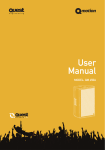Download Quest Engineering HPI111 User manual
Transcript
User Manual MODEL: HPI111 Contents Safety Precautions . . . . . . . . . . . . . . . . . . . . . . . . . . . . 1 General Description. . . . . . . . . . . . . . . . . . . . . . . . . . . . 3 Getting The Best From Your HPI111 . . . . . . . . . . . . . . . 4 Flying the HPI111 . . . . . . . . . . . . . . . . . . . . . . . . . . . . . 6 HPI111 Specifications. . . . . . . . . . . . . . . . . . . . . . . . . . 8 HPI111 Reference Diagram. . . . . . . . . . . . . . . . . . . . . . 9 User Manual HPI Series HPI111 HPI111 User Manual Safety Precautions • Be sure to read the instructions in this section carefully before use. • Make sure you observe the instructions in this manual as the conventions of safety symbols and messages are very important. • We also recommend you keep this instruction manual handy for future reference. Safety Symbol and Message Conventions Safety symbols described below are used in this manual to prevent bodily injury and property damage which could result from mishandling. Before operating your product, read this manual first and understand the safety symbols and messages so you are thoroughly aware of any risks. 1 WARNING Indicates a potentially hazardous situation which, if mishandled, could result in death or serious personal injury. HPI Series HPI111 User Manual HPI111 User Manual WARNING When Installing the Unit When the Unit is in Use • Do not expose the unit to rain or an environment where it may be exposed to water or other liquids, as doing so may result in damage to the bass driver or corrosion of the steel protective grill. • Do not cut, kink, otherwise damage nor modify the speaker cable. Also use speaker cable of at least 1.5mm core diameter. In addition, avoid locating the speaker cables close to heaters, high traffic areas or locations where the cables can be damaged. 2 • Avoid installing or mounting speaker boxes in unstable locations and when flying, use the hardware designed for the speaker box and fix securely to a solid wall. Failing to do so may result in the unit falling, causing personal injury and/or property damage. • Turn down the amplifier before switching on the amplifier. If there is no sound, check the speaker connections. Speakon connectors must be locked in place. • Should any of the following irregularities be found during use, immediately switch off the amplifier power, disconnect the power supply plug from the AC outlet and contact your nearest Quest dealer: • If you detect smoke or a strange smell coming from the unit, • If the unit falls and the unit case is damaged, • If it is malfunctioning (no HF or low frequency output). Make no further attempt to operate the unit if it is found to be in any of the above conditions as this may cause fire or electric shock. • Be sure to ground to the safety ground (earth) terminal to avoid electric shock. Never ground to a gas pipe as a catastrophic disaster may result. • Never hang a speaker box from only one rigging point. Use multiple points and attach a safety line to a point strong enough to take the weight of the speaker box. WARNING User Manual HPI Series HPI111 Flying the box from one insert must not be attempted! Improper installation may result in damage, injury or death. HPI111 User Manual General Description The HPI 111 is a full frequency range multi-purpose 2-way passive speaker system designed for the live sound touring and permanent installation market. It is suited to full range front-of house sound for mid-throw applications in both stand alone applications or as part of a small array. Its versatility means it can also be configured in multiple numbers as a multi-way system with sub bass enhancement or individually as part of a compact portable full range system with single sub bass enhancement. (See HPI Series bass speaker systems). The HPI 111 differs from the HPI 110 in that it has a wide dispersion 1” horn flare that can be rotated through four planes of dispersion. This makes the HPI 111 an ideal choice for single element installations or as a delay speaker supporting an HPI 110 array. The HPI111 requires no special system processor and can be installed in a vertical or horizontal installation with the horn flare rotated to give the appropriate HF dispersion. Features The HPI111 has a number of features designed to increase performance and versatility for a professional sound installation environment. A great deal of attention was paid to the details of the design to make the HPI111 both sonically excellent and functionally suited to all aspects of mobile and permanently installed sound reinforcement. High Powered Purpose Designed Components A high powered frequency driver is matched to the 1 inch exit high frequency asymmetrical wave guide. The result is a reliable and high fidelity high frequency response with a uniform mid throw and wide dispersion capability. The high efficiency 10” mid-bass transducer has been designed to function in a relatively large volume enclosure to maximize low frequency output. The cone geometry and driver dynamic parameters are also engineered to give a smooth frequency response into the vocal range. Good vocal and midrange response makes the HPI111 an exceptional performer when it comes to vocal projection and reproduction of acoustic instrumentation. Functional Design For easy maneuvering and loading, an integrated carry handle also doubles as part of the rigging system and also serves to give the casing more strength and rigidity. 3 The recessed input panel allows for protection of the plastic Speakon connectors and also aids a visually tidy installation. Solid Build Construction Built for a touring environment, the HPI111 is well suited to all professional applications. The timber casing is reinforced birch ply with a heavy gauge power-coated steel grill. Like all Quest products, it is “built tough for a tough world”. HPI Series HPI111 User Manual HPI111 User Manual Getting The Best From Your HPI111 Connections Suitable Amplification The HPI111 is an 8 ohm enclosure and can be connected in multiple parallel connections to an amplifier channel that can operate at speaker impedances of 4 ohms. The HPI111 is a mid power level high efficiency system, so ultra high power is not necessary to obtain high sound pressure levels. The recommended power range per amplifier channel is 450-500 watts RMS into an 8Ω load. The HPI111 is ideal for use with the Quest QA 2004/3004 models. Two Neutric Speakon model NL-4 connectors are mounted in a recessed panel on the rear surface of the box. This allows the speaker box to be set flat against a wall without physical interference to the speaker connector. Setting the QA amplifier’s high pass filter at 35Hz is recommended for full range applications. If you are intending to add sub bass speakers or use for mainly vocal reproduction, the high pass filter can be set to 80Hz. • The connector input is wired pin 1+ and pin 1-. • Pin 2 is not connected. 4 Take care when inserting the Speakon connector twisting the connector until it locks into place. Reverse the procedure to disconnect. 10 10 5 5 1 1 OFF 35Hz Reducing low frequency output will make more amplifier power available for clean vocal reproduction for full range sound, set the high pass filter to 35Hz 80Hz HIGHPASS-A 1 2 CAUTION OFF 35Hz 80Hz STEREO PARALLEL BRIDGE HIGHPASS-A OFF 80Hz 1.4V MODE 32dB 26dB OUTPUT A GAIN RISK OF ELECTRIC SHOCK DO NOT OPEN 110Hz LOW PASS-A LINKA INPUTA PIN1: SIGNAL G N D PIN2: SIG N AL + PIN3: SIGNA L - BRIDGE MODEL : OUTPUT ASSIGNMENT PIN1+ : S IGN A L PIN1-: G ROUND PushToReset HIGHPASS-B OFF 35Hz 80Hz LOW PASS-B OFF 80Hz LIMITE R 110Hz ON GROUND OFF LIFT GROUND DESIGNED BY QUEST ENGINEERING,AUSTRALIA LINKB INPU T B OUTPUT B ~ 220 240V 10A 50/60Hz Recommended HPI111 Amplifier Configuration User Manual HPI Series HPI111 HPI111 User Manual Speaker cables Speaker cable needs to be as heavy gauge as conveniently possible for low-loss results. Light gauge cable (below 1.5mm) will create extra resistance and waste amplifier power. This particularly applies to long speaker runs. The amplifier’s damping factor statistic (“punch” for the non technical) is greatly diminished, so keep your speaker cables short and as heavy gauge as practical. Speaker Placement as a Single Box or in Arrays The HPI111 is intended for use as a single speaker system or as part of a multiple speaker setup with or without sub bass reinforcement. It can also be installed in small arrays of up to three boxes per array for very wide coverage applications. When a group of point source 90 degree speaker boxes are placed together, it is possible to have “interference effect” between some of the boxes causing uneven frequency response. This can be particularly noticeable in the mid-high frequency area. If you intend to set up the HPI111 as part of a multiple box array, see the section ‘Flying the HPI111’. When positioning the speaker system on a stage, make sure the HF horn at the top of the speaker box is above the heads of the audience. At full power the output of the HPI111 is very high and hearing damage can result from short to medium term exposure. For best results when the HPI111 is used as a front of house speaker, consider angling the box forward slightly to direct the HF horn to cover the audience area. The HF horn should be aimed away from the ceiling and focused on the intended area of coverage. This will minimize HF reflections, lower the reverberant field in the room and give better intelligibility. Installation Hardware The HPI 111 can accept the same hardware as the HPI 110. For horizontal installation the ACHPiWB110 bracket can be used for tidy installation. 5 Ideal HPI111 Flown Configuration HPI Series HPI111 User Manual HPI111 User Manual Flying the HPI111 6 The HPI 111 can be flown in a permanent installation by attaching the designed flying hardware. The HPI111 can be wall mounted or hung in a flown installation using the flying fitting accessory. For more information, see the Quest HPI flying hardware manual. Before suspending any speaker system always inspect all components (enclosure, rigging frames, eyebolts, track fittings, etc.) for cracks, deformations, corrosion, missing, loose or damaged parts that could reduce strength and safety of the array. Do not suspend the speaker system until the correct preparation of the installation site has been taken to avoid health risks during and after the completion of the installation. A licensed Professional Engineer must approve the placement and method of attachment to the structure prior to the installation of any overhead object. Rotating the Horn Flare The asymmetrical horn flare can be rotated through three separate planes of dispersion depending on the speaker box requirement and installation environment. The planes are suited to either vertical or horizontal installations. Good coverage of audiences often requires wide dispersion at the base of the horn flare to cover close listeners and a focused narrow dispersion at the top of the flare to beam to the back of the room. The HPI111 horizontal horn covers both “short-throw” and “long-throw” requirements in a single system. For the majority of installations (where the box is installed vertically), the asymmetrical horn should be used as supplied and will not need to be rotated. For horizontal installation rotate 45 degrees so the arrow is pointing at the floor side so as to have the “beaming” facility at the top of the horn. WARNING User Manual HPI Series HPI111 Ensure the box is securely located. If any doubt about the physical stability, tie the box down with ratchet straps to a secure base. HPI111 User Manual HPI111 Wave Guide Examples 45° +15˚ -45˚ 90°-100° 7 HPI111 Vertical Side HPI111 Vertical Front 45° +15˚ 90°-100° HPI111 Horizontal Front -45˚ HPI111 Horizontal Side HPI Series HPI111 User Manual HPI111 User Manual HPI111 Specifications Typical Frequency Reponse HPI111-Frequency Reponse _ 1W (dB) Level, Sound pressure 110 100 90 80 70 60 8 50 20 50 100 200 500 1k 2k F: Frequency Response - 1W @ 1m 1/3 octave smoothing Technical Specifications User Manual Power Handling 400W RMS Frequency Response 70 – 18 kHz (+/-3dB) Sensitivity 1 watt @ 1 Meter 96dB Maximum SPL @ 1m 128dB Impedance 8 ohms Connections and Wiring 2x Speakon NL4 - 1+/1- (2+/2- through) Woofer 10” Ferrite Woofer Tweeter 1” exit ferrite compression driver Directivity Asymmetric 90 Horizontal ; +15/-50 vertical Dimensions 641.5 x 306 x 352 mm Weight 19.4Kg (42.7 lbs) HPI Series HPI111 5k 10k 20k Frequency (Hz) HPI111 User Manual HPI111 Reference Diagram 1 3 4 4bis 9 8 11 12 8 10 2 5bis 5 1 9 7 7bis 6 No. Description Spare Part 1 Complete grille (includes acoustic foam) HGHPI111 2 Rotative Q-badge 25mm (with spring-loaded pin) HQB25 3 Asymmetric horn flares for HPI111 HWG111 4 Compression Driver 1” exit (ferrite, 1.75”voice-coil, 40Wrms) T1012 4bis Compression driver recone (diaphragm) RT1012 5 Woofer (ferrite 10", 2.5"voice-coil, 300Wrms) T10005 5bis Woofer dedicated recone kit RT10005 6 Steel pole mount bottom plate HPP110 7 Rubber skids (137mm) HSK137 7bis Rubber skids (52mm) HSK52 8 Internal metal brace - 1 (Top) HIB110-1 9 Internal metal brace - 2(Centre) 10 Internal metal brace - 3(Bottom) 11 Aluminum handle for HPI111 12 Connection plate HCP110 13 Passive filter network for HPI111 (x-over) AXHPI111 14 Manufacturer plate for HPI110 HIB110-2 HIB110-3 HAH111 HMP110 HPI Series HPI111 User Manual Register Your Product Thank you for choosing Quest. Please take the time to complete your product registration card which is included with the packaging. Registering your Quest Engineering product will: • CONFIRM YOUR WARRANTY • REGISTER YOUR PRODUCT • PROTECT YOUR NEW PRODUCT REGISTER ONLINE: www.questaudio.net/registration www.questaudio.net




















